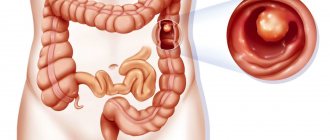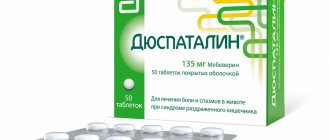Materials and methods
52 patients (16 men and 36 women) aged from 26 to 59 years (average age 40.2 years) were examined. The diagnosis of IBS was based on the Rome III criteria [1]. Before diagnosis, patients were observed for at least 4 months, during which clinical symptoms were systematically recorded, signal symptoms suggesting the presence of organic pathology were excluded, laboratory blood tests were performed 2-3 times, including a complete and biochemical blood test, antigliadin antibodies and antibodies to tissue transglutaminase, carried out bacteriological examination of feces, performed ultrasound examination of the intestines, irrigoscopy, colonoscopy. Of the 52 patients, 7 were diagnosed with IBS with a predominance of constipation, 3 with IBS with a predominance of diarrhea, and 42 with IBS of a mixed type.
The criteria for inclusion in the study were the diagnosis of IBS, established as a result of a thorough clinical, laboratory and instrumental examination; signing the informed consent form.
The main criteria for exclusion from the study were the onset of IBS symptoms at the age of over 50 years; diseases of internal organs in the terminal stage; any history of laparoscopic and laparotomic surgical interventions; pregnancy, breastfeeding, inability to use adequate contraception during treatment and for 1 month after the last dose of the study drug; presence of allergy/intolerance to any of the components of the medications used in treatment, including lactose intolerance; drug use, antipsychotics, alcoholism, mental illness of the patient; presence of active tuberculosis, viral hepatitis B or C, or a history of HIV infection; taking medications belonging to one of the following groups: drugs affecting the gastrointestinal tract - gastrointestinal tract (laxatives, prokinetics, antispasmodics, opiate receptor agonists, carminatives), antibiotics, non-steroidal anti-inflammatory drugs, psychotropic drugs, probiotics, other drugs , affecting the functional state of the intestine.
During the observation period, patients made 5 visits to the doctor: before starting therapy, after 2 weeks, 1, 2 and 3 months of therapy. During each visit, the severity of IBS symptoms (abdominal pain, bowel dysfunction, flatulence) was assessed using a visual analogue scale - VAS (VAS-IBS questionnaire), determination of the visceral sensitivity index - VSI (VSI questionnaire), quality of life (QoL) study. patients with IBS (IBS-QoL questionnaire) and assessment of stool shape according to the Bristol scale.
Patients took the drug Kolofort in the first 2 weeks, 2 tablets 3 times a day, from the 15th day - 2 tablets 2 times a day (until complete absorption in the oral cavity) for 2.5 months.
At the beginning of the study and after the end of treatment, venous blood samples were taken from all patients for the study of cytokines: tumor necrosis factor-α (TNF-α), interleukin-1β (IL-1β) and interleukin-10 (IL-10). Cytokines were determined using an enzyme-linked immunosorbent assay on a StatFax-3000 ELISA analyzer using Vector-Best test systems (Novosibirsk).
Patients were examined after signing voluntary informed consents in accordance with the Declaration of Helsinki of the World Medical Association, which regulates scientific research. The study was approved by the ethics committee of the Federal State Budgetary Institution Research Institute of Ministry of Railways.
Statistical processing of the obtained data was carried out using the Statistica 6.0 application package. The statistical significance of differences was analyzed using the t
Student's test.
Differences were considered statistically significant at p
<0.05.
Kolofort tablet d/rassas pack cont cell/pack card x100
Dosage form COLOFORT tab. for resorption: 20, 40 or 100 pcs. reg. No.: LSR-006226/10 dated 07/01/10 - Registration period. beat not limited Release form, composition and packaging Flat-cylindrical lozenges, scored and chamfered, from white to almost white in color. On the flat side with a mark there is the inscription MATERIA MEDICA, on the other flat side there is the inscription KOLOFORT.
1 tab. antibodies to human tumor necrosis factor alpha affinity purified 0.006 g* antibodies to brain-specific protein S-100 affinity purified 0.006 g* antibodies to histamine affinity purified 0.006 g*
* applied to lactose in the form of a mixture of three active aqueous-alcoholic dilutions of the substance, diluted 10012, 10030, 100200 times, respectively.
Excipients: lactose monohydrate, microcrystalline cellulose, magnesium stearate. Description of the dosage form Tablets: flat-cylindrical with a score and a chamfer, from white to almost white. On the flat side with a notch there is the inscription “MATERIA MEDICA”, on the other flat side there is the inscription “KOLOFORT”.
Pharmacological action Pharmacological action - regulating the functions of the gastrointestinal tract. Pharmacodynamics It has been experimentally shown that the components of the drug modify the activity of the ligand-receptor interaction of endogenous regulators with the corresponding receptors: antibodies to the S-100 protein - to serotonin receptors and sigma-1 receptors, antibodies to TNF-α - to the TNF-α receptor, antibodies to histamine - to H4-histamine receptors localized in the gastrointestinal tract.
The combination of three active components allows for a complex effect on the central and peripheral links in the pathogenesis of functional intestinal disorders, incl. abdominal pain syndrome.
Antibodies to protein S-100 have a wide range of psychotropic activity, including anxiolytic and antidepressant, antiasthenic and nootropic effects, which are clinically manifested in the elimination of internal tension, anxiety, normalization of a number of visceral functions, incl. activity of the large intestine. They do not have a sedative effect, do not cause addiction, or withdrawal symptoms.
Antibodies to TNF-α have a pronounced anti-inflammatory effect and help normalize the balance of pro-inflammatory and anti-inflammatory cytokines.
Antibodies to histamine have antispasmodic, anti-inflammatory, and decongestant effects.
The combined use of components in the complex drug helps to normalize the nervous and humoral regulation of intestinal function, reduce the visceral hypersensitivity of colon receptors to distension, ensuring restoration of impaired gastrointestinal motility, relieving the sensation of bloating and fullness of the stomach, and reducing the severity of pain. The antispasmodic effect of the drug is manifested by relaxation of smooth muscles and a decrease in the tone of the gastrointestinal tract wall, a decrease in intraluminal pressure, normalization of stool consistency, its frequency and accompanying symptoms (including relief of urgency, tenesmus, a feeling of incomplete bowel movement, reduction of additional efforts during defecation) .
Pharmacokinetics The sensitivity of modern physicochemical methods of analysis (gas-liquid chromatography, high-performance liquid chromatography, gas chromatography-mass spectrometry) does not allow assessing the content of ultra-low doses of antibodies in biological fluids, organs and tissues, which makes it technically impossible to study the pharmacokinetics of the drug Kolofort.
Indications for the drug Kolofort: irritable bowel syndrome,
functional disorders of the gastrointestinal tract.
Contraindications Increased individual sensitivity to the components of the drug.
Side effects Reactions of increased individual sensitivity to the components of the drug are possible.
Interaction Cases of incompatibility with other drugs have not been registered to date.
Method of administration and dosage: Orally, not during meals, keep in mouth until completely dissolved.
For one dose - 1 or 2 tablets. Take 2 times a day. The course of treatment is 1–3 months; if necessary, the course of treatment can be extended to 6 months and/or repeated after 1–2 months. Against the background of exacerbation of diseases, it is possible to increase the frequency of administration to 4 times a day for a period of 7 to 14 days.
Overdose Symptoms: dyspepsia may occur due to the excipients included in the drug.
Special instructions The drug contains lactose, and therefore it is not recommended for use in patients with congenital galactosemia, glucose or galactose malabsorption syndrome, or congenital lactase deficiency.
Impact on the ability to drive vehicles and operate machinery. Kolofort does not affect the ability to drive vehicles and potentially dangerous machinery.
Release form Lozenges. In blister packs made of PVC film and aluminum foil, 20 pcs. 1, 2 or 5 blister packs in a cardboard pack.
, 127473, Russia, Moscow, 3rd Samotechny lane, 9.
Tel..
Conditions for dispensing from pharmacies Without a prescription.
Storage conditions for the drug Kolofort: Protected from light, at a temperature not exceeding 25 °C. Keep out of the reach of children.
The shelf life of the drug Kolofort is 3 years.
Results and discussion
We analyzed the dynamics of clinical symptoms characteristic of IBS during treatment with Kolofort for 3 months. Abdominal pain 2 weeks after starting Kolofort, as assessed by VAS, tended to decrease. After 1 month or more of therapy, this dynamics reached statistical significance. A similar picture was observed when analyzing complaints of flatulence, which decreased significantly after 2 weeks of therapy; subsequently this pattern increased (Table 1).
Table 1. Dynamics of symptoms during treatment of IBS with Kolofort Note. Here and in the table. 2: Data are presented as M±m.
One of the leading pathogenetic links in IBS is a change in visceral sensitivity. Pronounced positive dynamics of IHF was observed after 1 month of therapy, with further significant improvement by the end of treatment (Fig. 2, a).
Rice. 2. Dynamics of HDI (a) and the content of TNF-α and IL (b) during treatment of IBS with Kolofort.
Subjective assessment of the severity of problems that concern patients in connection with stool disorders changed faster than stool shape during treatment with Kolofort. Statistically significant positive dynamics of stool shape were recorded only after 2 months of treatment, while the dynamics of anxiety associated with stool disturbances turned out to be significant after 2 weeks of treatment (see Table 1).
Psychological status is of great importance in the management of patients with IBS. We used the VAS assessment of mental well-being and the impact of IBS symptoms on daily life, as well as the assessment of mental well-being using the IBS-QoL questionnaire to determine the dynamics of psychological parameters during treatment with Kolofort. Subjective assessment of the dynamics of these parameters demonstrated obvious positive changes, which reached statistical significance after 1 month of therapy, and subsequently this dynamics increased (Table 2).
Table 2. Dynamics of psychological parameters and total QOL score during treatment of IBS with Kolofort
From our point of view, the data obtained from studying the dynamics of the content of cytokines in the blood: TNF-α, IL-1β and IL-10 before the start of treatment and after 3 months of therapy deserve special attention. The level of TNF-α as a result of using Kolofort for 3 months decreased statistically significantly. Similar patterns were not observed for the content of IL-1β and IL-10 (see Fig. 2, b). The possibility of the influence of inflammatory mechanisms on visceral hypersensitivity, neuroendocrine interactions and motility of the digestive tract in patients with IBS is actively discussed in modern works [7]. The results of a meta-analysis published in 2014 indicate a trend ( p
=0.09) to increase the content of TNF-α in patients with IBS compared with healthy individuals [4].
A reasonable question arises: how did one drug achieve a multidirectional positive effect in the treatment of patients with IBS. In this regard, it is necessary to pay attention to the composition of Kolofort, which includes release-active antibodies to the S-100 protein (eliminate internal tension, anxiety, normalize visceral functions, including the colon), release-active antibodies to histamine (provide antispasmodic, anti-inflammatory , anti-edematous effect), release-active antibodies to TNF-α (have a pronounced anti-inflammatory effect) [8, 9]. The effectiveness of Kolofort is achieved through a combined complex effect on the main links in the pathogenesis of IBS. Kolofort influences the ligand-receptor interactions of the brain-specific protein S-100 with serotonin and σ1 receptors in the central nervous system (CNS), histamine with histamine H4 receptors localized in the gastrointestinal tract and regulates (modifies) the functional activity of TNF-α. The regulatory effect of the drug at the level of the central nervous system, autonomic nervous and immune systems is manifested by a calming, antispasmodic, anti-inflammatory effect, which together effectively normalizes gastrointestinal motility.
The composition and mechanism of action of Kolofort are shown schematically in Fig. 3. Thus, the pathologically substantiated multidirectionality of the obtained effects of Kolofort is explained by the 3 components included in its composition, which is fundamentally important given the multifactorial nature of IBS.
Rice. 3. Composition and mechanism of action of Kolofort.
It must be emphasized that much attention is currently being paid to the development of approaches to the treatment of patients with IBS. New systematic reviews and guidelines for the treatment of IBS have emerged in recent years in the USA [10], Europe [11] and Asia [12]. This emphasizes the extreme relevance of the emergence of new drugs with innovative composition and the ability to act on various pathogenetic components of IBS.
Colofort lozenges 100 mg No. 100
A country
Russia
The country of production may vary depending on the batch of goods. Please check with the operator for detailed information when confirming your order.
Compound
Active substances: Antibodies to human tumor necrosis factor alpha (TNF-α) affinity purified - 0.006 g * Antibodies to brain-specific protein S-100 affinity purified - 0.006 g * Antibodies to histamine affinity purified - 0.006 g * Excipients: lactose monohydrate, cellulose microcrystalline, magnesium stearate.
* applied to lactose in the form of a mixture of three active aqueous-alcoholic dilutions of the substance, diluted 10012, 10030, 100200 times, respectively. Description Flat-cylindrical tablets with a score and a chamfer, from white to almost white. On the flat side with a mark there is the inscription MATERIA MEDICA, on the other flat side there is the inscription KOLOFORT.
Release form Lozenges. 20 tablets each in a blister pack made of polyvinyl chloride film and aluminum foil. 1, 2 or 5 blister packs together with instructions for medical use are placed in a cardboard pack.
Pharmacological properties
It has been experimentally shown that the components of the drug modify the activity of ligand-receptor interaction of endogenous regulators with the corresponding receptors: antibodies to the S-100 protein - to serotonin receptors and sigma 1 receptors;
antibodies to TNF- - to the TNF- receptor; antibodies to histamine - to H4 - histamine receptors localized in the gastrointestinal tract (GIT). The combination of three active components allows for a complex effect on the central and peripheral links in the pathogenesis of functional intestinal disorders, including abdominal pain syndrome. Antibodies to protein S-100 have a wide range of psychotropic activity, including anxiolytic and antidepressant, antiasthenic and nootropic effects, which are clinically manifested in the elimination of internal tension, anxiety, normalization of a number of visceral functions, incl. activity of the large intestine. They do not have a sedative effect, addiction, or withdrawal syndrome. Antibodies to TNF - have a pronounced anti-inflammatory effect and help normalize the balance of pro-inflammatory and anti-inflammatory cytokines. Antibodies to histamine have antispasmodic, anti-inflammatory, and decongestant effects. The combined use of components as part of a complex preparation helps to normalize the nervous and humoral regulation of intestinal function; reducing visceral hypersensitivity of colon receptors to stretching, ensuring restoration of impaired gastrointestinal motility; relieving the feeling of bloating and fullness of the stomach, reducing the severity of pain. The antispasmodic effect of the drug is manifested by relaxation of smooth muscles and a decrease in the tone of the gastrointestinal tract wall, a decrease in intraluminal pressure, normalization of stool consistency, its frequency and associated symptoms (relief of urgency, tenesmus, feeling of incomplete bowel movement, additional effort during defecation, etc.). Pharmacokinetics The sensitivity of modern physicochemical methods of analysis (gas-liquid chromatography, high-performance liquid chromatography, gas chromatography-mass spectrometry) does not allow assessing the content of ultra-low doses of antibodies in biological fluids, organs and tissues, which makes it technically impossible to study the pharmacokinetics of the drug Kolofort.
Indications for use
Irritable bowel syndrome; functional disorders of the gastrointestinal tract.
Contraindications
Increased individual sensitivity to the components of the drug.
Mode of application
Inside. For one dose - 1 or 2 tablets (keep in mouth until completely dissolved - not during meals). Take 2 times a day. Course of treatment - 1 - 3 months; if necessary, the course of treatment can be extended to 6 months and/or repeated after 1-2 months. Against the background of exacerbation of diseases, it is possible to increase the frequency of dosing up to 4 times a day for a period of 7 to 14 days.
Side effect
Reactions of increased individual sensitivity to the components of the drug are possible.
Overdose
In case of accidental overdose, dyspepsia may occur due to the excipients included in the drug.
Interaction
No cases of incompatibility with other drugs have been reported to date.
special instructions
The drug contains lactose, and therefore it is not recommended for use in patients with congenital galactosemia, glucose or galactose malabsorption syndrome, or congenital lactase deficiency. Kolofort does not affect the ability to drive vehicles and other potentially dangerous mechanisms.











